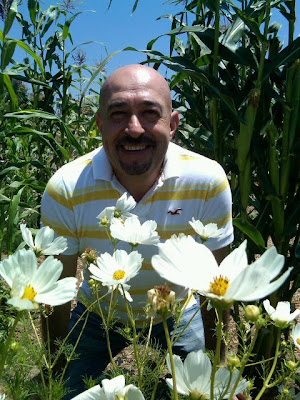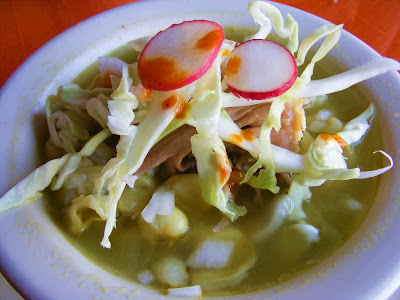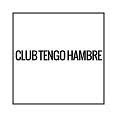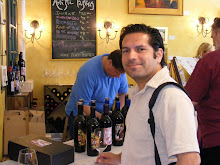
For the past 12 years Jaime Martin del Campo and Ramiro Arvizu have been bringing authentic Mexican cuisine to Los Angeles from their native state of Jalisco, and beyond. This is no contrived marketing of authentic Mexican, but secrets, traditions, and subtleties that have spanned generations.
When they first opened
La Casita Mexicana in Bell, CA back in ’98, some locals were perplexed by their menu items, “no es comida mexicana!” One woman, Ramiro recalls,threw a plate of
enchiladas at them because there were no rice and beans, they weren’t baked, nor did they have the salty, metallic flavors of a canned sauce. Little by little, the boys charmed the local crowd and convinced them to give this strange cuisine a try.
Chiles en nogada, the state dish of Puebla has been on the menu since day one.

Ramiro Arvizu was born in Tecolotlan, Jalisco where he grew up before coming the United States in 1977. His culinary heritage dates back to the haciendas of Mexico in the kitchens of the elite in pre-Revolutionary Mexico. He learned to cook from his grandmother, who passed the recipes and techniques of her mother,Ramiro's great-great grandmother, who had been a cook for one of the most well known families in the area.It was the lavish dinners of wealthy creoles that shaped Ramiro’s culinary DNA. His great-great grandmother prepared dishes from all over Mexico,beautifully plated,as well as international cuisines.
His grandmother had a
cenaduria called
La Cenaduria de Dona Chuy in Tecolotlan, where Ramiro grew up. Chuy is a nickname for Jesus, his grandmother’s name. There he ate his family’s
pozole,
sopes, regional Mexican plates, and other soulful
antojitos(little whims).
In 1977, Ramiro and his family came to Los Angeles, where his father opened a restaurant called El Indio. There they made there own tortillas from house prepared nixtamal for making tortillas,a
molino for grinding spices, and cooked using many substitutions due to the lack of Mexican ingredients at the time. Sour cream was used in the place of
crema Mexicana. This restaurant lasted a few years before closing.
Ramiro loved to travel and wanted to see the world. He got his AA at East LA City College, and then attended the Travel and Tourism Academy of the Pacific. He got a job for Aeromexico, where for five years, he traveled all over Mexico researching hotels, tourist attractions, and yes, restaurants. For Ramiro, it was dancing the night away in Cancun, flying to Monterrey just to devour
cabrito al pastor(spit roasted kid),and
chocolata clams on the beach in La Paz. Ramiro wined and dined in Mexico like a VIP.
He then began working for China Airlines where he learned from his co-workers while on stops in China about real Chinese food,”Ramiro, this is real Chinese, that is not.” He also had been dreaming of bringing real Mexican to Los Angeles, and cooking was always his true passion. So, it was fate that led him to a banquet hosted by another airline about 20 years ago. The main attraction was Mexican cuisine laid out in a beautiful color scheme. Ramiro asked, “who cooked these dishes?” “There was a
mole negro, seven interesting and tasty salsas, a stuffed round of
panela cheese, and a fabulous
rajas con crema”, the two founders of La Casita Mexicana recalled.At the end of the party, he was introduced to the person responsible:Jaime Martin del Campo.

Jaime Martin del Campo was born and raised in Tototlan, Jalisco,in the highlands of Jalisco, where he also learned to cook with his grandmother. He wanted in the kitchen from day one, but had to sneak around to learn about his family’s cuisine because men weren’t supposed to be in the kitchen. That didn’t stop Jaime.
They even made their own cheeses, slaughtered goats to make
birria, it was a food lover’s dream to grow up on that ranch in tequila country. Jalisco produces the most cheese of all the states in Mexico. They made
jocoque,
requeson,
panela, and Jalisco style
tamales, bread,
sopa de elote, and of course,
moles. They even milked the cows and goats for making the cheese.
Jaime, always an independent spirit, left for the big city at the ripe old age of 15,in Guadalajara, the capitol of Jalisco. There he studied and earned a B.A. in travel and tourism, and partied like a mad man until his late 20’s. Guadalajara has one of the mosty vibrant nightlife scenes in all of Mexico. There it was tequila, dancing ‘til 6AM, street food, and as always, cooking for his friends.
When Jaime arrived to the states, around the mid-eighties, a friend took him out for a burrito. Jaime hadn’t really heard of a burrito before and was shocked. He scolded his friend while spitting out a bit of stor bought tortilla, cheese product, and IMO sour cream,”this isn’t Mexican food…you’re from Jalisco, and you know better!!” Right then and their his contempt turned into a vision, one of bringing the food he grew up on to Los Angeles by opening a restaurant.
After working odd jobs to survive, Jaime, also a travel buff, landed a job in his area of study working for the Indonesian carrier, Garuda Airlines. His week was filled with international travel, and the on Fridays he went shopping for ingredients so that he could craft special Mexican dinners for his friends. He even brought his own food on trips so that he could cook where he landed.
Jaime was an uncompromising practioner of authentic Mexican cuisine since day one, and while his friends marveled at his great food, he was perfecting, practicing, and learning. When he cooked for that pot luck some 20 odd years ago, he arrived early to prepare and present, a labor that was driven by the pride of his Jaliscan heritage.
After Jaime and Ramiro had been introduced, they met at another function and got to talking about Jalisco, cooking, and about opening a restaurant of their own.
Ramiro cashed in his 401K, and both sold off most of their personal belongings to open
La Casita Mexicana. They wanted to make a traditional
cenaduria, like the ones they grew up with. A
cenaduria is a supper house featuring the cooking of women. Home cooking style restaurants in Mexico,
cenadurias, and
fondas were traditionally for the working men who wanted their wives’ and mothers’ cooking when away from home.
Cenadurias are open in the evenings, but this is America, so,” we are a
cenaduria that’s open all day”, Ramiro smiled. The first menu had among other items:quesadillas with
flor de calabaza,
mole poblano, green and red
pipianes, tortas, and
chiles en nogada. Ramiro was so nervous the first day that he had to make the rice around seven times, because he kept thinking it wasn’t any good.
It took about three years for the restaurant to really be accepted by the neighborhood, the local population consisted of many Mexican-Americans who knew nothing of traditional Mexican cuisine. The subtleties and plating were radically different for many. “You mean,
enchiladas don’t come with beans and rice, and melted cheese ?” They drizzled their
moles and
pipianes on the chips to get people used to the flavors, stoking their interest in this sauce. Most households made mole from Dona Maria jar of industrial mole paste.
Now,
La Casita Mexicana is humming along. Regular appearances on Univision, invites to the James Beard awards, a
rave review from Jonathan Gold and other local publications, magazine reviews, a
chile relleno beatdown on Bobby Flay, and they’ve just expanded to open a store next to their restaurant.
The restaurant has been getting better and better in the several years I’ve been going, and the pair of chefs take regular trips to Mexico to continue their studies.I Just recently was fortunate to have sampled a delicious and sweet
mole de xico they learned from a woman on their recent trip to Vera Cruz. The cooking at their restaurant features gastronomy from their home state of Jalisco and regional Mexican cuisine. The ingredients are genuine, and the two chefs have gone to great lengths to procure their native ingredients, even knocking on strangers doors if they happen to have a bitter orange tree on their property, offering to buy the otherwise unused sour citrus fruit. They work with some urban gardens around town that grow
nopales(cactus),
romeritos, and other valuable products from home.
While
La Casita Mexicana have done so many complex dishes for special events, it would be a mistake to overlook their daily menu.
La Casita Mexicana is the only restaurant of its kind that still resides in a traditional latino neighborhood which is definitely in the boondocks. They get a mixed crowd, but it’s often the locals that are there ordering these fantastic regional plates. I have a feeling Bell can’t keep these guys forever, but in the meantime, don’t be afraid to ask if there are any specials, or have one of the guys whip you up something off menu. But seriously, this is a
cenaduria, and its real gift to Los Angeles isn’t to impress with names of plates, but to deliver deep, soulful cooking from the heart of Mexico, the food of their grandmothers. This is authentic Mexican.
 Pozole verde
Pozole verde, though the state of Guerrero is known for green pozole, they also do this dish in Jalisco, but of course, Jalisco style. Here is dish that Jaime and Ramiro grew up with, a beautiful pozole like no other in town. This soup is green from
tomatillo,
serrano chiles,
poblano peppers, cilantro, and fresh
epazote. Ramiro told me that “the corn in Guerrero is cooked more soft, we like it al dente”. The slow cooked pork soaks up all those aromas, and adds comfort to this pre-Columbian dish. It was made with turkey, or other native proteins before the arrival of the
conquistadores. The other two
pozoles at La Casita, red and white, are delicious,too.

The quesos fundidos(cheese fondues) at La Casita Mexicana are must have starters.The
Queso Frito “La Casita Mexicana” uses their house blend of panela, oaxaca, cotija, and queso fresco with a touch of epazote. The cotija is a salty cheese and is included to impart its mineral qualities. They’re perfect for stuffing into Jaime and Ramiro’s house made tortillas with guajillo chile mixed into the masa, or the tortillas blended with nopal(cactus).

Have you heard about the breakfasts at
La Casita Mexicana? The aromas of sweet
café de la olla(pot coffee with cinnamon) and chiles linger stimulate the chismes(gossip), and familial celebration.
Chilaquiles verdes(green), rojos(red), or go divorciados(divorced), both red and green on either side of the plate. It’s more of an amicable split! Get the
chilaquiles with La Casita’s
mole poblano,
pipian rojo, or
pipian verde.
Classic
huevos rancheros and other egg preparations, or omelettes filled with cactus and mushrooms that are inspired cover the tables. This is the best traditional Mexican breakfast eatery in town. It’s like being at Café Tacuba in Mexico City on a Sunday morning.

The
ceviche verde is perfect.
Epazote,
yerba buena(mint),
hoja santa,
chile serrano , fresh
chile de arbol ,
jalapeno, a bit of chile poblano, lettuce, cilantro, and garlic are blended with lime to create a tangy, nuanced composition. The multi-layered
ceviche juice tames the strong flavor of the pollock used in this plate. It’s finished this sea salt and a drizzle of olive oil.

There are a couple of baked fish entrees, on this visit it was fish filet in an
adobo of
guajillo and
ancho chiles. Here a simple fish is glorified in medium spice, brilliant color, and just the desired level of season. Try their more subtle
Filete de Pescado con Chile Morita or Al Chipotle if you want your lips to tingle with pleasure.
.JPG)
I was not always wowed by Jaime and Ramiro’s
cecina(salt cured beef) plates when I first tried started going around three years ago.Often they were ordinary and the meat lacked tenderness. I never minded because there were so many other dishes to choose from. But, I recently had their
Cecina al chipotle and it was a more delicate texture and the chipotle soaked tomatoes were great. Looking at some older photos of
cecina I’d ordered a couple of years ago, the present version even looks better. The boys are always tweaking, playing, and perfecting.
The
Plato “Conquista” is another classic meat option at
La Casita Mexicana, a thin steak over grilled cactus and oaxacan cheese, covered in a
chile guajillo sauce.

Not on the regular menu, but quite easy for them to whip this up for you,
Relleno de Chile Guero filled with the house cheese blend.
La Casita Mexicana takes their chiles rellenos seriously, and know that these dishes are the pride of a family’s kitchen. There are so many tired chiles rellenos around town filled with jack cheese and cooked by indifferent line cooks

At
La Casita Mexicana, you get a variety of stuffed chiles, battered, not battered, and with interesting fillings, as they should be, as you would encounter in Mexico. The chile relleno de verduras is a roasted
poblano pepper in a light tomato sauce,packed with a sautee of cactus, mushrooms, tomatoes,and onions.

You can’t go wrong with La Casita Mexicana’s stuffed
chiles, but the truest indulgence is Puebla’s celebrated state dish,
Chiles en Nogada. An elegant roasted poblano pepper stocked with a savory, sweet picadillo of minced pork,dried fruits, candied cactus, and nuts, blanketed in a fresh walnut sauce during the season and creamy pecan sauce for the off-season ,and crowned with fresh pomegranate, when in season .
Chiles en Nogada season runs from around August through early October.This is Mexican
haute couture,and a difficult dish to balance. The presentation adheres to the original recipe as created for the first emperor of Mexico, Agustin de Iturbide by Pueblan nuns, which was not battered. It’s a challenge to join these flavors, it often tastes like three separate dishes that shouldn’t be paired, but
La Casita Mexicana knows that the key is in the picadillo, which bridges the spice, and sweetness of the recipe. The same little cenaduria that brings hearty pozole,deftly performs the opulent, and sophisticated
Chiles en Nogada. Excellence!
 La Casita Mexicana
La Casita Mexicana is also house of
moles. You get a taste as soon as you’re seated, all three of their labor intensive sauces are on the chips that come to your table.
Enchiladas tres moles with chicken or cheese, comes the dark
mole poblano (Pueblan mole), pipian rojo, and pipian verde(red and green pumpkin seed moles).
The moles are an exhausting trio of sauces to maintain, made fresh daily in the restaurant, though they are labors of love. The
pipian rojo is a favorite of mine
 Mole
Mole is a dish you pass down from generation to generation. Most home cooks remember the day when their
abuelita sat them down and said, “it’s time you learned how to make our mole.” Whole restaurant empires have risen from such profound gestures, and some of these guarded secrets have been liberated for all to share the wealth by cookbook authors such as Diana Kennedy.
Jaime and Ramiro’s
mole poblano has 46 ingredients as given to them by their grandmothers. Unsweetened chocolate, with
chiles guajillo,
ancho, and
mulato, spices, stale bread, fruits, seeds, and nuts that are toasted, ground, liquefied, blended, cooked, and stirred to reveal an intense color and aromatic mélange.

And, the desserts? The
traditional Mexican flan is as good as it gets. The desserts at La Casita are the memories of their grandmothers, who indulged Jaime and Ramiro, as all grandmothers do, with the best sweets fit for their favorite grandsons.
The texture, the sweetness, the flavor.Amazing.

Those little coconut candies stuffed into candied lime are given a more esteemed presentation than their usual street sweets vendors can afford. These are too good, it just isn’t fair.
 Envueltos de arroz con leche y crema de nuez
Envueltos de arroz con leche y crema de nuez, the sweet rice with milk stuffed in a pastry with a walnut sauce shows a flair for invention.

The
Guayabas(guavas)in rompope(Mexican egg nog)fit for a king.

Just recently, Jaime and Ramiro opened a store next door, specializing in gift baskets full of Mexican food products. It’s like walking into an open air market, there are
moles, bread, candies, coffees, and even sweet cooked agave as a snack.

The gift baskets are perfect for your novia, abuelita, or Dia de Madre(Mother’s Day).

The
Tiendita(little store) is open, and authentic Mexican is here, as it has been for the last 12 years. Jaime and Ramiro have brought the cuisine of their home towns, the food that has passed from generation to generation.
Whether it be a classic Mexican breakfast experience, a mole tasting, classic comfort food, or the high cuisine of Mexico,
La Casita Mexicana is a leader in bringing the best and truest Mexican food to Los Angeles, and the US.
It may be the only
cenaduria that’s open for breakfast, lunch, and dinner, but no need to fret. My only dilemma is whether to do breakfast, lunch, or dinner?
These two chefs have given everything they had to show us real Mexican cuisine, they are the antidote to the adulterated Mexican restaurants of the combo plate variety, and can strike fear into the kitchens of
superficial celebrity chefs trying to sell their beads and glass to us native Angelinos.
Come taste the authentic flavors of Mexico. Buen Provecho.
La Casita Mexicana4030 Gage Ave
Bell, CA 90201
323)773-1898
Mon-Sun 9am-10pm














